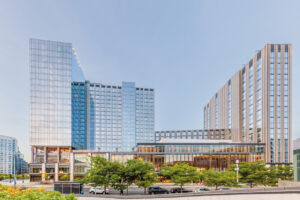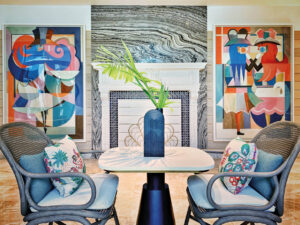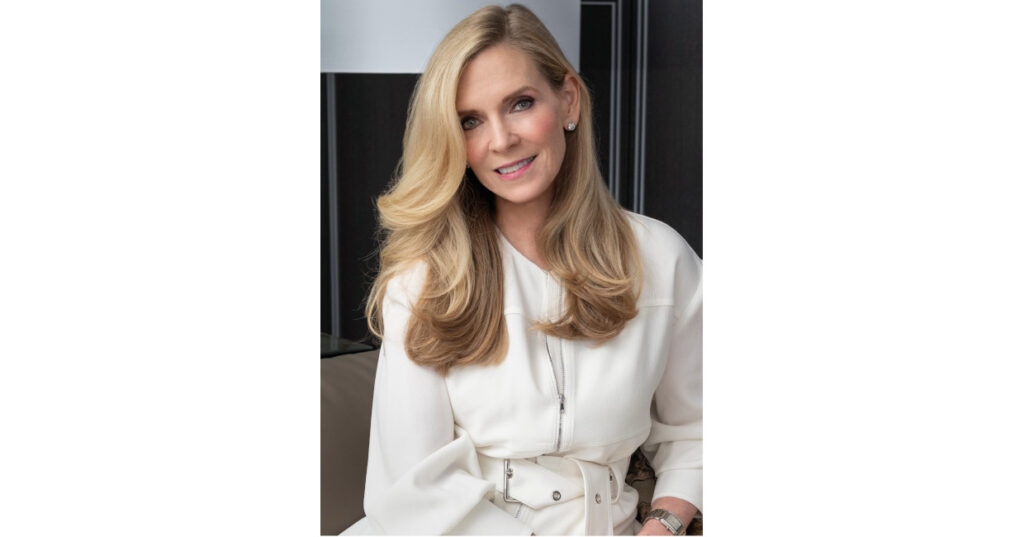Visionary and all-round powerhouse, Elizabeth Lowrey, talks to Sophie Harper about her career to date and how she hopes the future of hospitality design is an altogether more inclusive environment.
Dubbed a ‘maverick’ and ‘silo-buster’ for her diversity and cross-industry design approach, Elizabeth Lowrey is not merely a designer, but a mentor for architectural designers of the future and a prime example of what an industry leader should look like.
Elizabeth grew up in a family of artists and designers and says she naturally loved hospitality design from the get-go. “I knew by the age of six that I wanted to be an architect,” she says. “I’d spend hours sketching fantasy hotels and resorts. During the summers, my dad would be an artist in residence and teacher at art schools like Haystack on the Maine coast, Penland in North Carolina, and Marfa, Texas. My mother was a designer and artist and worked in museums before becoming an artist full-time. We kids would run through the studios, playing with clay, begging to blow glass, making vegetable dyes, and generally being the teacher’s mascots.”
“In high school, I sought out classes that would let me practice, visualise, draw, and create. I remember being the only girl in the architectural drafting class, where I fell in love with a whole new world of industrial design and engineering. When the time came, I started Auburn University planning to major in architecture. I shifted my major to interior architecture after learning more about it.”

After graduating, Elizabeth made the move from North Carolina to Boston and landed a job at Vesti International. “Vesti was hired to design the new airport in Riyadh. Gensler was producing the construction documents and the design of the public spaces. We were designing the VIP spaces, and I ended up working directly with Art Gensler and Orlando Diaz Acuzy.”
When Vesti closed later that year, Elizabeth went to Jung Brannen. She recalls how on a Sunday morning in 1988, she was having brunch at home with a friend when she got a call from Howard Elkus. “Howard was already legendary, having worked with Walter Gropius at The Architects Collaborative (TAC). He asked if I wanted to talk about joining a new firm that he and fellow TAC alum David Manfredi were starting. I immediately said yes and asked what day the following week was good, to which Howard replied, “No, no! Today!” So I spent that afternoon with him. We had breakfast with David the next morning, I turned in my resignation the next day, and joined as employee number one at Elkus Manfredi Architects.”
“I accepted their offer so quickly because Howard and David got it – they had the urban planning and architecture talent and expertise, but they didn’t have the interior design expertise. They knew that to do really great work they needed all three disciplines, and they were giving me the opportunity to start a studio. I became a principal of the firm in 2002 and now we are 50 people in the interiors practice. I had the best of all worlds because I got to be an entrepreneur while having the experience of David and Howard behind me.”
Project involvement
Talking about her role and work on a day-to-day basis, Elizabeth tells me how she’s still involved in every project, overseeing the design and being a conduit with the client to support and advance the strategic design process. “I go from meeting to meeting – client meetings and working with teams on creative pursuits, whether it’s designing a project or brainstorming for an RFP. I’m usually out at night for work or charity events. I travel a lot for inspiration and am always in pursuit of new ideas – art, culture, fashion. It’s a balancing act. I’m a designer, colleague, mentor, leader, wife, daughter, sister, mother, friend – many of those roles overlap at different times during a typical workday.”
A naturally charitable and considered woman, Elizabeth explains how important philanthropy is to her and how it forms part of her everyday activities too. “I work closely with MassArt (Massachusetts College of Art and Design), the country’s only public art school, as well as Heading Home, which focuses on homeless families. Delivering inspiring, highly functional, and deeply inclusive spaces where people can thrive is the first and most important aspect of our work. Beyond that, what drives me? Giving back to my community, which includes the architecture, design, and real estate industries and continuing to build my network by connecting people. As I was growing up in the American South, my parents were always involved in social justice, so I had role models in the sense of participating in the community and giving back. I hope that my efforts will benefit the next generation.”
Having been in the industry for the length of time she has, I was interested to hear what changes Elizabeth had observed over the course of her design career within the hospitality sector. “There have been two major changes,” she says, “the pandemic and the rise of GenZ – who bring with them their philosophy of social responsibility and acceptance, blending work and play, healthy living, and diversity that is changing everything.”
“Another change is that 72% of millennials prefer to spend money on experiences rather than material things. It’s a common denominator across hospitality: you leave with an experience and memories.”
Adding to this, Elizabeth says that a change in general attitude towards travel has resulted in demand for sustainability. “Sustainable, environmentally supportive design is imperative. Guests and employees increasingly want to know they are part of the change, not part of the problem, so the property’s carbon footprint must be minimal.”
“Health and wellness is another accelerating trend and goes hand-in-hand with sustainable design. When surveyed, 98% of Hilton guests cited wellness – including mental health, healthful eating, and physical fitness – as a top priority when travelling. Universal design will become the norm whether required by regulation or not. No barriers, easy access and flow for everyone – young or old, in a wheelchair or on a skateboard. Materials will be sustainable and healthy to be around. Designers will have to be proactive on environmental considerations and understand that the building codes are only going to become more stringent.”
Elkus Manfredi

Elkus Manfredi, known for its award-wining designs and 360-degree service from architecture and master-planning to interior design and historic preservation, has a number of projects on the go at all times, and Elizabeth tells me what the studio is working on currently. “Right now we’re finishing the White Elephant Nantucket, and also working on an entertainment complex in Everett, Massachusetts, that will be connected via pedestrian bridge to Wynn’s Encore Casino. The first phase includes a sports bar, a poker room, a nightclub that can fit nearly 1,000 people, a roof-deck ‘day club’, a 980-seat theatre, and a 200-seat comedy club.”
“I think hospitality designers are going to start hearing the word ‘entertainment’ a lot more. Because of the pandemic, coupled with what social media has done to us with our addiction to flashing images and instant gratification, there’s a huge desire for entertainment. Entertainment can mean the kinds of spaces we’re designing in Everett, and can also mean learning, relaxing, reconnecting, detoxing – anything that supports good mental health.”
Elizabeth tells me other projects underway include the TMC3 Collaborative Building and the Industry Building, which are the first two structures on the site of TMC3, a new biomedical research and translational science campus planned immediately south of the Texas Medical Center in Houston for which Elkus Manfredi also did the master plan. “The Collaborative Building is a hub of innovation where five universities and hospitals come together to collectively cure cancer. The Industry Building is a state-of-the-art research space for the translation of basic research into new therapies and institutions. For this project we’re applying hospitality design strategies to create the connections that spark scientific innovation among scientists of all kinds. We’re also designing a law office for a confidential client, a seven-building student residence hall in the Midwest, and amenity spaces for two office buildings. While each is a different project type, they all benefit from design strategies derived from hospitality. Conversely, our workplace projects are informing our hospitality projects as the hospitality industry adapts to the brave new world of remote working.”
The future
Looking ahead, Elizabeth says she’s excited for the future of hospitality design and shares her hopes for the industry. “The world is changing, and our story is about silo-busting, borrowing solutions and approaches across industries to solve new design problems. While we thought about diversity before, we have a new lens and a new urgency. As leaders, we have a responsibility to enable and participate in that conversation and to act on what we learn. As designers, we need to be very aware of what impact we’re having. My hope for the future is that we prioritise inclusivity throughout the design process rather than just in the final product. By involving a diverse range of users in the process, we can create environments that truly make people feel they belong. Ultimately, I hope that our industry can refuel around passion and purpose. Our jobs are to inspire, delight and create beautiful environments in which people can thrive.”
www.elkus-manfredi.com



